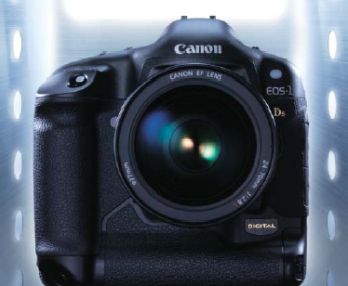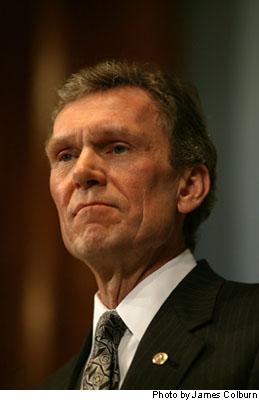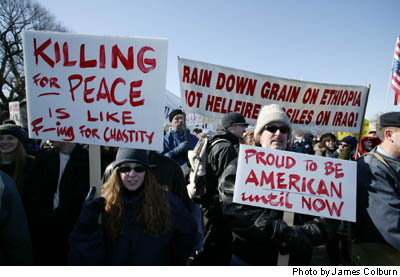| Canon EOS-1Ds
Review
February 2002
by James Colburn |

|
 Let
me start by saying that the Canon EOS-1Ds is the first digital camera
to produce what I consider to be film-quality images. At it's best settings
it produces a 4064 X 2704 pixel image that translates into a 31.5 Mb
TIFF file. As a comparison a 2700 dpi scanner (like a Nikon LS-2000
Coolscan) will produce a 28 Mb scan from a 35mm negative. That's good
enough for a magazine cover or a double page spread and that's something
that hasn't been available before now. Not only is the image BIG but
it's beautiful. It's sharp and, aside from a slight greenish cast in
some of the shadows, the colors are rich and true-to-life. Let
me start by saying that the Canon EOS-1Ds is the first digital camera
to produce what I consider to be film-quality images. At it's best settings
it produces a 4064 X 2704 pixel image that translates into a 31.5 Mb
TIFF file. As a comparison a 2700 dpi scanner (like a Nikon LS-2000
Coolscan) will produce a 28 Mb scan from a 35mm negative. That's good
enough for a magazine cover or a double page spread and that's something
that hasn't been available before now. Not only is the image BIG but
it's beautiful. It's sharp and, aside from a slight greenish cast in
some of the shadows, the colors are rich and true-to-life.
You know it's a good camera when you see photographers fighting over
who gets to use it.
It's not really a camera though. It's more like a digital imaging computer
that just happens to accept Canon EOS lenses. The long-used and much
ignored geek-speak adage RTFM (Read The F***ing Manual) is very important
with the Ds because if you ignore that manual you'll wind up kicking
yourself. This camera will do things that previous generations of cameras
only hinted at. Open the box, take out both manuals (hardware and software)
and read through them both before you even pick up the camera. Trust
me, you WILL have to read them eventually anyway.
 This
camera goes beyond Average White Balance, Daylight, Tungsten and Fluorescent.
If you want to set it for 3100K or 4600K then just dial it in. If you
want to warm things up just a touch bump it up to 7000K. This camera
also allows you to bond with your television brethren when you ask someone
to hold up a piece of paper, again, so that you can do a white balance.
It will even White Balance BRACKET automatically so you can take a three
shot series with one at 4800K, one a 5500K and one at 7500K. That, dear
readers, is amazing. This
camera goes beyond Average White Balance, Daylight, Tungsten and Fluorescent.
If you want to set it for 3100K or 4600K then just dial it in. If you
want to warm things up just a touch bump it up to 7000K. This camera
also allows you to bond with your television brethren when you ask someone
to hold up a piece of paper, again, so that you can do a white balance.
It will even White Balance BRACKET automatically so you can take a three
shot series with one at 4800K, one a 5500K and one at 7500K. That, dear
readers, is amazing.
You can adjust the sharpness of an image (similar to Photoshop's Unsharp
Mask.) You can adjust the degree of JPEG compression. It seems like
you can adjust damn near everything and you can do it IN THE CAMERA.
You can also capture and save an image as a "raw" file and
do everything to it (color temperature adjustment, sharpness, etc.,
etc., etc.) in your computer AFTER you transfer the image to a computer.
Canon's supplied File Viewer Utility will let you (with a Firewire connection
twixt camera and computer) allow you to go deeper into the camera's
operating system to adjust "Personal Function Settings" on
your Ds. Want to set the minimum and maximum shutter speeds available?
Done. Want to limit the number of shots you can do during continuous
shooting? Done. Have you ever wanted to make the Quick Control Dial
on the back of your EOS work in the opposite direction? Why? Darned
if I know. But now you can. It almost seems that this camera allows
an almost ridiculous level of control, but that's a good thing.
The metering and exposure options (Program, Tv, Av, etc.) will be familiar
to anyone that used a Canon EOS camera and they seem to work very, very
well. Heavily back-lit shots taken without fill flash were usable but
fill-flash (with a 550EX) is automatic and accurate. It handles well,
is nicely balanced and weighs about the same as an EOS-1 with a motor
drive.
 It has every bell and every whistle available. If you try this camera
you will want this camera. And that, my friends, is the only problem
I found with the EOS-1Ds. It is expensive. It has an Manufacturer's
Suggested Price of $8999, maybe $7500-8000 at a discount..... Each.
It has every bell and every whistle available. If you try this camera
you will want this camera. And that, my friends, is the only problem
I found with the EOS-1Ds. It is expensive. It has an Manufacturer's
Suggested Price of $8999, maybe $7500-8000 at a discount..... Each.
To put that into some sort of perspective a gee-I'd-like-to-own-one-but-can't-justify-the-expense-because-I'll-only-need-
it-four-times-a-year 600mm f/4 lens costs $7000. A new Honda 750 motorcycle
costs $5800. A luxury villa in the south of France rents for $5000 a
month....
It is expensive.
You will need very fast Compact Flash cards (at least 24X) and they'll
have to be big ones, 512Mb or 1Gb. And you'll need a few of them. Big?
They have to be big because the 128Mb cards you've been using will hold
all of 25 high resolution JPEGs produced by the Ds and if Raw files
are your bent each 128Mb card will hold five images. It may get to a
point one day when news photographers will have a "back to the
future" moment and say "Excuse me, I have to change my film
holder between shots" as they did in the days of 4x5. Fast? I found
that filling the camera buffer (ten shots) took about three seconds
(at 3.5 frames per second) and writing those ten shots to my 1X or 2X
128Mb CF card took almost two minutes.... Two minutes during which you
can't take any pictures, can't remove the CF card, can't do much of
anything except look at the red "I'm busy writing to disk"
light and pray that a Pulitzer Prize winning picture doesn't happen
right in front of you. Plan on getting a Firewire Compact Flash card
reader too because USB just won't cut it anymore. The High Res JPEGs
produced by a Ds weigh in at 4Mb each.
 Two bodies, four 1Gb cards and two 550EX flashes will set you back $19,000.
I can't see a freelancer wanting, or being able, to pay the cost of
a new car for a brace of Ds cameras when a Canon D-60 (for those times
when you need "speed") and a good scanner (for the times when
you need higher quality) will cost $3500.
Two bodies, four 1Gb cards and two 550EX flashes will set you back $19,000.
I can't see a freelancer wanting, or being able, to pay the cost of
a new car for a brace of Ds cameras when a Canon D-60 (for those times
when you need "speed") and a good scanner (for the times when
you need higher quality) will cost $3500.
So this camera, as wonderful as it is, is a corporate purchase, not
an individual one. At least Canon seems to have realized that by allowing
for up to three Custom Function Groups so that three photographers with
different preferences can easily change the camera's custom functions
without scrolling through 14 menus every time they trade off a camera.
If your magazine or paper values quality above all or you really have
enough high-res-hungry clients to justify buying a Ds do it. You'll
love the camera. Your friends will be jealous. You will be the "Big
Dog."
I'm planning to buy one in early 2005 when I should be able to pick
an "obsolete" EOS-1Ds for around $500. I'm going to use some
old 128Mb CF cards. I'm going to put it on a tripod and use a darkcloth
over my head when I focus. I'm going to take it very, very slow.
© James Colburn
Contributing Writer
jecol@aol.com
|